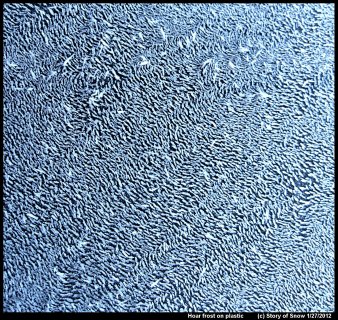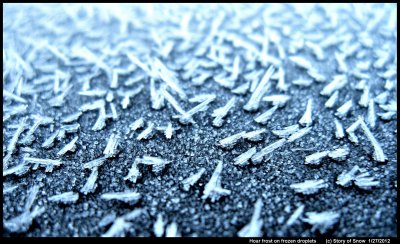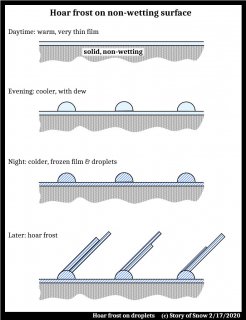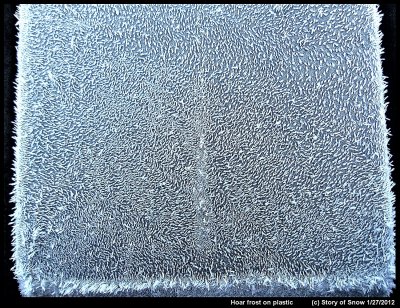| « A Stroll on a Mildly Frosty Morning | Raindrop Hillocks and Ground Ice » |
Hoar Frost on Plastic
The pattern of hoar frost depends on not just the current and prior conditions, but also on the surface. If the surface is less attractive to water, that is, more hydrophobic, then the hoar crystals tend to be more further spaced apart.
Or even more widely spaced apart. (Click on an image to enlarge it.)
These two images show hoar frost on plastic surfaces (garbage bin lids). If you look closely at the above picture, you will see that the hoar columns are growing off little mounds. These mounds are frozen droplets. You'll also notice that the directions of the ice columns are not random, but instead a given ice column tends to be pointing in nearly the same direction of its neighbors.
The droplets formed because the meltwater (i.e., pure liquid water) does not completely wet the surface. So, even though a very thin melt film likely exists under relatively dry conditions, this film does not grow thicker when the relative humidity increases (as it does on glass). Instead the extra water vapor condenses into droplets. Such a situation occurs when the surface cools in the evening. One may see dew droplets, as sketched below, which later freeze. Hoar frost is the ice that then grows from the vapor, essentially being "seeded" by the frozen film and droplets.
Because the underlying thin film also froze, the crystal orientation of the nearby droplets are the same (as in the above drawing). In a real case, unless the crystal orientation is just right, the crystal structure bends as the ice spreads across the surface during freezing, making the crystal orientations of nearby hoar slightly different, with the further the spacing, the further apart in crystal orientation. Thus, in the above hoar frost images and in the one below, the pattern curves and swirls, like sticks floating around whirlpools.
You see this twisting of the crystal structure in the bending fern-like patterns in film frost. As far as I know, the exact reason for the twisting has yet to be discovered. Though some ideas have been advanced, they are not quantitative. I know of only one experimental study of the phenomena, and that was many decades ago. It would be a great study to do if someone could fund it (i.e., pay me).
I find some of these patterns mesmerizing, so I leave with one more.
--JN



